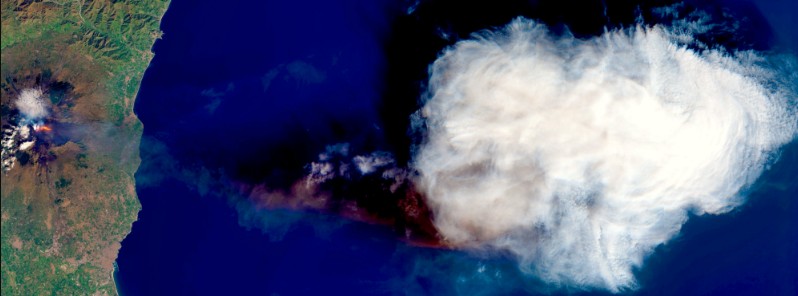7th spectacular paroxysm at Etna volcano produces heavy ashfall, Italy

A sudden increase in volcanic tremor detected at Etna's Southeast Crater at 07:44 UTC on Sunday morning, February 28, 2021, quickly led to another spectacular paroxysm — the 7th since February 16.
This paroxysmal episode was characterized by a remarkable intensity and short duration, with the activity of tall lava fountains lasting about 30 minutes.
The fountaining peaked at 08:25 UTC and stopped almost suddenly at 08:33 UTC, while the lava flow towards Valle del Bove remained active.



Ash column rose several kilometers above the crater and spread into a large umbrella cloud.
Etna, very rapid paroxysm, the 7th in the series!
Photo: Maria Liotta pic.twitter.com/Kp0GR1y3qh— Szabolcs Harangi (@szharangi) February 28, 2021
Le #volcan #Etna vu du dessus et du dessous ce 28 février 2021.
Photo @parrinelloluigi pic.twitter.com/3yv3zOGD4V— Meteo60 sur Telegram www.t.me/meteo60 (@meteo60) March 1, 2021
#Etna eruption this morning pic.twitter.com/ZAXTU9y1Un
— aarcidia (@aarcidia) February 28, 2021
New, very brief and rather powerful paroxysmal eruptive episode at #Etna's Southeast Crater, 28 February 2021 morning. Sub-Plinian eruption column seen from home in Tremestieri Etneo, 20 km south of Etna's summit pic.twitter.com/fyLRamWPLs
— Boris Behncke (@etnaboris) February 28, 2021
A 7th #paroxysm of the #Etna volcano occurred this morning
The impressive ash plume emitted during the eruption was captured by @CopernicusEU #Sentinel2 at 9:50 UTC, about 1h and 30 min after the event pic.twitter.com/y7M38BPtwF
— DG DEFIS #StrongerTogether (@defis_eu) February 28, 2021
Heavy ashfall was reported ESE of the volcano, particularly in Zafferana, Milo and Fornazzo villages where 1 – 2 cm (0.4 – 0.8 inches) of ash was reported.
Members of the VolcanoDiscovery Team observed the eruption from approximately 10 km (6.2 miles) distance in a location between Fornazzo and Sant'Alfio, at the very edge of the ash fallout.
"Even there, black scoria of up to 3 cm (1.2 inches) in diameter were falling like hail during a storm, causing us to seek shelter under a roof," volcanologist Tom Pfeiffer said.


A significant bush fire started during the peak phase of yesterday's activity in the Valle del Bove near or on the southern slope of Monte Rinato, Pfeiffer added.
"Initially, the appearance of fumes from this area raised speculations of a possible new vent in the Valle del Bove, but soon were discarded. The cause of the fire remains speculative, but most likely, it was ignited by an exceptionally far-traveled hot volcanic bomb that landed in an area of dense, dry vegetation yesterday."
Geological summary
Mount Etna, towering above Catania, Sicily's second-largest city, has one of the world's longest documented records of historical volcanism, dating back to 1500 BCE.
Historical lava flows of basaltic composition cover much of the surface of this massive volcano, whose edifice is the highest and most voluminous in Italy.
The Mongibello stratovolcano, truncated by several small calderas, was constructed during the late Pleistocene and Holocene over an older shield volcano. The most prominent morphological feature of Etna is the Valle del Bove, a 5 x 10 km (5.1 x 6.2 miles) horseshoe-shaped caldera open to the east.
Two styles of eruptive activity typically occur at Etna. Persistent explosive eruptions, sometimes with minor lava emissions, take place from one or more of the three prominent summit craters, the Central Crater, NE Crater, and SE Crater (the latter formed in 1978).
Flank vents, typically with higher effusion rates, are less frequently active and originate from fissures that open progressively downward from near the summit (usually accompanied by strombolian eruptions at the upper end).
Cinder cones are commonly constructed over the vents of lower-flank lava flows. Lava flows extend to the foot of the volcano on all sides and have reached the sea over a broad area on the SE flank. (GVP)
Featured image credit: Copernicus EU/Sentinel-2

Commenting rules and guidelines
We value the thoughts and opinions of our readers and welcome healthy discussions on our website. In order to maintain a respectful and positive community, we ask that all commenters follow these rules:
We reserve the right to remove any comments that violate these rules. By commenting on our website, you agree to abide by these guidelines. Thank you for helping to create a positive and welcoming environment for all.